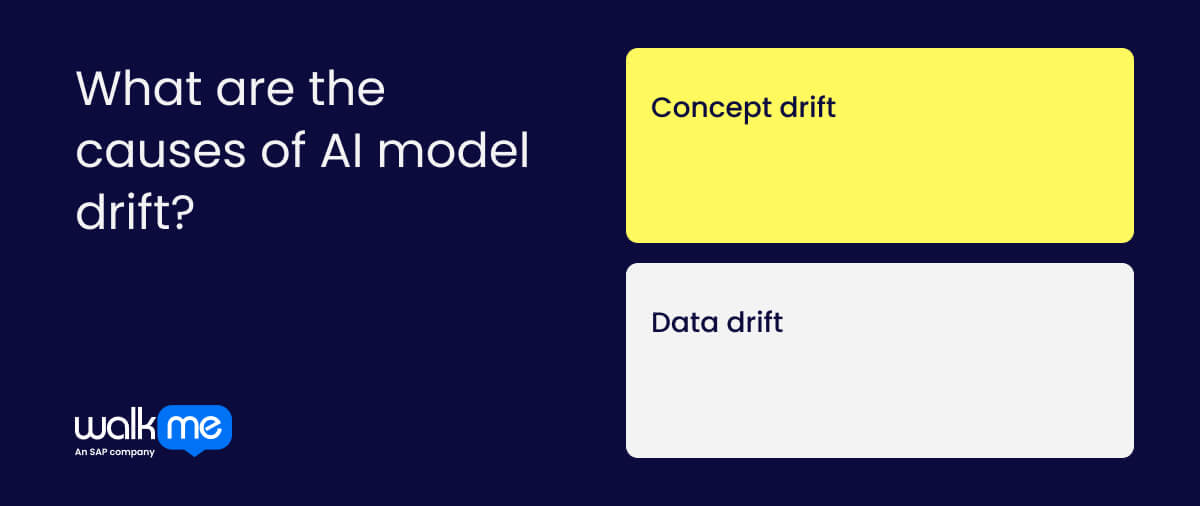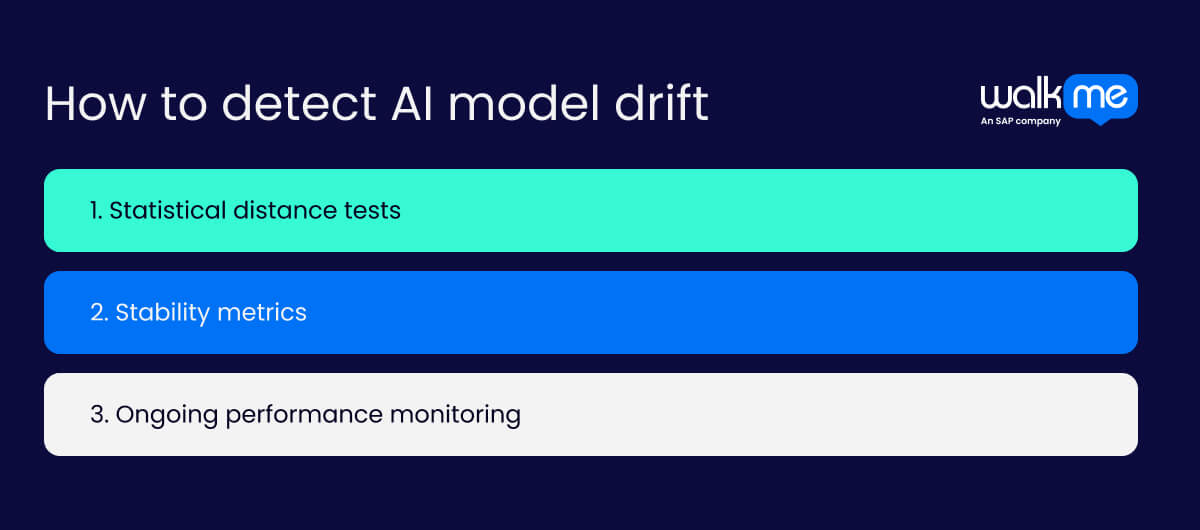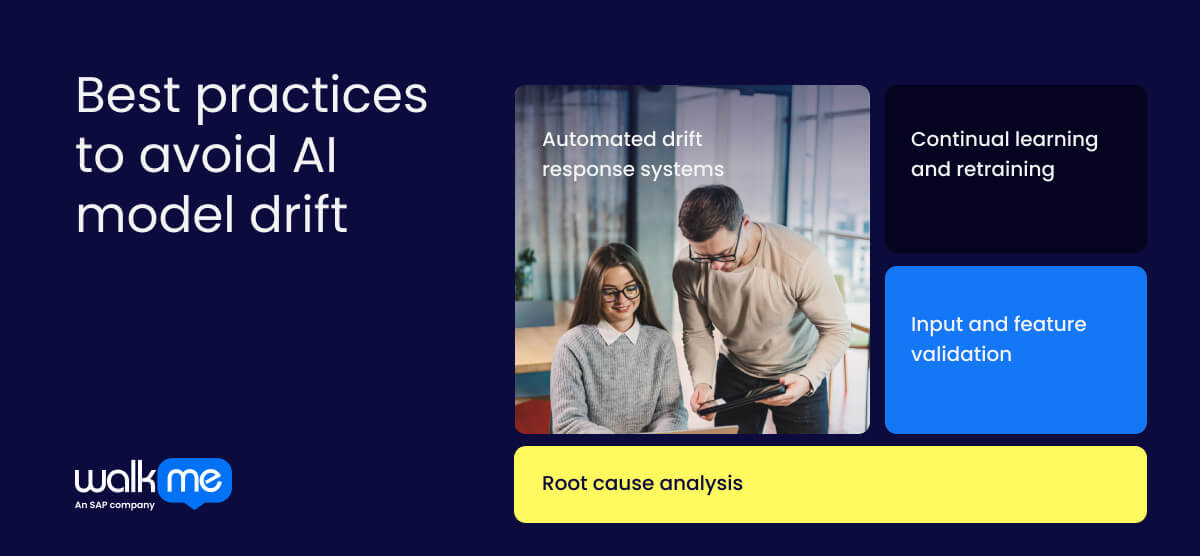What is AI model drift?
AI model drift occurs when a machine learning model’s performance degrades over time because the data it encounters in production changes from the data it was originally trained on.

This often happens when the underlying patterns or statistical properties of incoming data shift—a phenomenon known as data drift (changes in input data) or concept drift (changes in the relationship between input and output data). Causes can include changes in user behavior, market dynamics, external conditions, or modifications to software systems or data-generating sensors.
Model drift reflects a broader challenge in machine learning: models are static snapshots of past data, so they must be monitored and updated regularly to remain effective in evolving enterprise environments.
To manage drift, practitioners typically track metrics such as prediction accuracy, precision, recall, or distributional statistics, and retrain or fine-tune models as needed to maintain business performance and decision quality.
What are the causes of AI model drift?

The most common causes of model drift are concept drift and data drift. Other factors can also affect accuracy, such as input data being altered before it reaches the model (upstream data changes). Adjustments made to how the model is used—known as functional drift—can also have an impact.
Here is an overview of the primary drivers:
Concept drift
Concept drift happens when the relationship between the input data and the predicted outcome changes over time. For example, if a model learned to detect fraud based on certain behaviors, but those behaviors evolve, the model may start producing less accurate results. The task itself has not changed, but the real-world correlations that inform it have.
Data drift
Data drift occurs when the input data changes in ways the model wasn’t trained for. It can happen when incoming data no longer follows the same patterns the model learned from. For instance, the system might receive data from a new type of user whose behavior was not included in the training set. When the input shifts, the model may apply inappropriate logic, which weakens its output.
How to detect AI model drift

Detecting model drift involves checking whether a model’s performance remains stable after deployment. Monitoring tools can surface changes in the data or a drop in prediction quality. Some methods focus on how the input data changes, while others monitor the model’s predictive performance over time.
Here is an overview:
Statistical distance tests
Statistical tests help identify when the data going into a model no longer matches the data it was trained on.
- Kolmogorov–Smirnov test: Detects the largest difference between the cumulative distributions of two datasets.
- Cramér–von Mises test: Assesses how two datasets differ across their full distribution.
- Wasserstein distance: Measures the effort required to transform one dataset into another—also known as “earth mover’s distance.”
Stability metrics
Stability metrics indicate whether input features are changing in a manner that could impact model outputs.
- Population Stability Index (PSI): Compares the distribution of a feature in current data versus training data.
- Z-score: Identifies feature values that deviate significantly from the norm.
Ongoing performance monitoring
Live tracking helps detect drift by comparing predictions to real-world results over time through usage analytics.
Many teams use MLOps (Machine Learning Operations) toolkits to automate drift detection and alert stakeholders when retraining may be required.
- Accuracy score: Shows the percentage of correct predictions.
- F1 score: Balances precision and recall to account for both false positives and false negatives.
- Area Under the Curve (AUC): Measures how well the model distinguishes between outcome classes.
Best practices to avoid AI model drift

Avoiding model drift is essential to keeping AI systems reliable after deployment and requires ongoing AI optimization to maintain performance standards. When data or user behavior changes, even slightly, the model may start producing less accurate or inconsistent results.
The practices below help reduce the likelihood of drift and support long-term model performance:
Automated drift response systems
Automated tools monitor how a model behaves over time and flag unusual changes. Some systems identify which inputs may have contributed to the drift, allowing teams to review and retrain the model using more representative data. Others generate alerts when predictions fall outside expected confidence thresholds, enabling faster intervention.
Continual learning and retraining
Models often need to be updated as their operating environment evolves. Rather than retraining from the full original dataset, teams can adopt incremental learning strategies that integrate newer data in smaller, controlled batches. This approach helps models stay current while reducing the risk of overfitting or system disruption.
Input and feature validation
Unexpected changes in incoming data can impact results, even if the model logic remains unchanged. Input validation tools compare live data against training data to detect deviations. Monitoring the stability of key features during use helps teams identify anomalies before they degrade performance.
Root cause analysis
Understanding the source of drift enables more targeted and effective responses. Teams can use model explainability techniques to trace output changes back to shifts in input data or logic. This transparency supports more precise updates and reduces trial-and-error in retraining efforts.